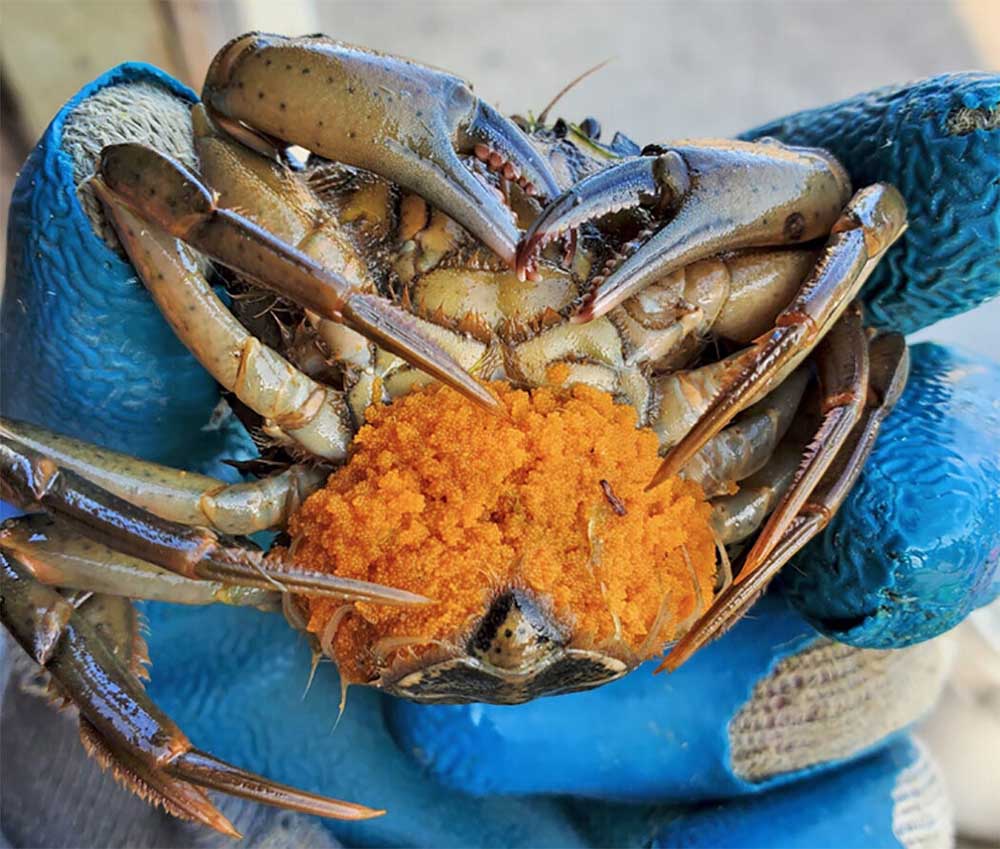Editorial: Fight against invasive species is here: Green crab are a prime example
Published 9:19 am Friday, September 15, 2023

- This egg-bearing European green crab was trapped in Willapa Bay this summer.
“Invasive pests are wreaking havoc across the planet, destroying crops, disseminating pathogens, depleting fish people rely on for food and driving native plants and animals toward extinction, according to a major report backed by the United Nations.” (The Washington Post, tinyurl.com/WAPO-invasives, Sept. 4, 2023.)
This comes as no surprise to anyone who pays attention. Willapa Bay and the Columbia River estuary both are on the front line when it comes to destructive animals and plants. Some species were brought here by accident. These include New Zealand mud snails — which can reach densities up to 44,000 per square foot — and spartina/cord grass that once threatened to turn the rich bay into a poor meadow. Others, notably the European green crab, are colonists transported on warming ocean currents and by other natural means.
Right now, green crab generate growing alarm in the Pacific Northwest, as they have since 2021. On Aug. 24, the director of Washington Department of Fish and Wildlife formally declared an emergency continues to exist and that all emergency measures should continue, as authorized last year by the governor. The 2023 Legislature provided $12 million for the fight in the current two-year funding cycle, and U.S. Sen. Patty Murray is lining up federal funds to help.
The crab are too small to be commercially valuable, but are so numerous and fast reproducing that they have seriously depleted clam populations in the Northeast U.S. and elsewhere. They eat whatever they can, in the process degrading local habitats including ecologically vital eelgrass beds.
WDFW, in its most recent briefing (tinyurl.com/WDFW-Sept-Green-Crab-Report), says 137,700 green crab were trapped and removed from state waters as of Aug. 9, including 34,000 here on the outer coast in July alone.
The spread of plants and animals between continents is one of the main causes of Earth’s ongoing biodiversity crisis, an extinction event on par with the asteroid that killed the dinosaurs. Invasive species are playing a role in 60% of extinctions.
Despite this effort, many green crab still infest the bay. Shellfish grower Warren Cowell and his crew have led the local intervention. On Sept. 6, he reported trapping 1,641 green crab — including 1,006 males and 370 females at Oysterville, including 18 females with eggs. He then ran low on bait, before Ron Neva stepped in with an ample supply. (See “Willapa Green Crab Disaster” on Facebook for ongoing updates.)
Money alone is clearly not the only answer to curbing the takeover of Willapa Bay. Though we’re still early in the fight and short-term logistical problems are likely to be resolved, any pause in managing green crab will make it that much more damaging to the region’s important shellfish industry and the complex web of life that depends on relatively unsullied estuaries.
Reporting on the UN-backed study, the Post says the spread of plants and animals between continents is one of the main causes of Earth’s ongoing biodiversity crisis, an extinction event on par with the asteroid that killed the dinosaurs. Invasive species are playing a role in 60% of extinctions.
Is there no good news when it comes to invasives? In fact, our region has so far been successful in keeping zebra mussels and other destructive freshwater shellfish out of the Columbia River watershed, where they would do enormous damage to hydropower and other infrastructure. Keeping such pests out is expensive and complicated, but far easier than trying to manage them once they become established.
“When invasive and non-native species become introduced into a location, the results can be devastating. From aquatic mussels to wild pigs, they can spread disease, feed on endangered species, compete for resources, overwhelm native species, reduce diversity, and often create cascading effects to the food web,” the Northwest Power and Conservation Council observed earlier this year.
Doing all we can to conserve native species and habitat is one of the 21st century’s most necessary and noble struggles. We must do all we can, personally and politically, to hold the line against the creeping chaos of these destructive species.









